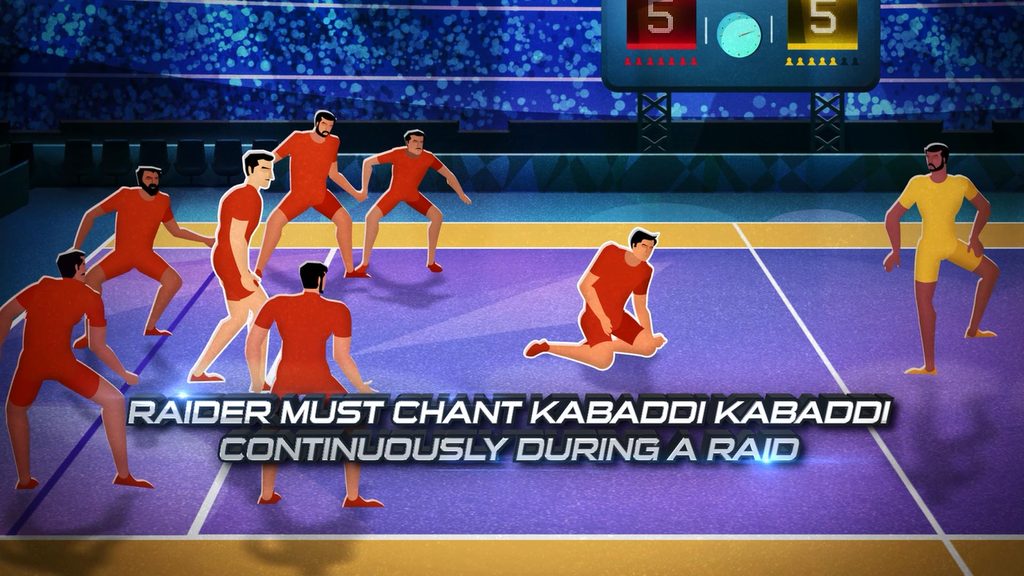In this comprehensive guide for beginners, we will take you through everything you need to know about Kabaddi rules. From understanding what Kabaddi is and its court dimensions to learning about players’ positions, terminologies, and basic and advanced rules of the game.
Kabaddi is a game that has been played in India for centuries and is now gaining popularity around the world. If you are new to the game, it can be overwhelming to understand all the rules and terminologies.
So whether you want to learn Kabaddi for fun or as a professional player, this guide is the perfect starting point for you!
What is Kabaddi?
Introducing a contact sport that originated in India, Kabaddi is gaining popularity worldwide as an exciting and fast-paced game. Played between two teams of seven players each, the objective of the game is for a player to tag and then return to their own half without being caught by the opposing team. However, it’s not as easy as it sounds! The game has various technical rules, including the raider’s chant, bonus line, and time limits for each raid. Understanding these rules can make all the difference in mastering this sport.
Kabaddi court
Understanding the layout of a Kabaddi court is crucial for players to succeed in the game. The rectangular court is divided into two halves, with each team having its own half. Players must stay within the boundaries of the court during play, and points are scored by tagging players on the opposing team and successfully returning to one’s own half. The court also has various zones, such as the bonus line, where teams can earn extra points, and the lobby, where players wait for their turn to raid or defend. Knowing these zones and their respective rules can give players a strategic advantage in the game.
Dimensions
Understanding the dimensions of the kabaddi court is fundamental to achieving success in the game. The standard kabaddi court is a rectangle measuring 13m x 10m and is divided into two halves by a line called the “midline”. Each half of the court has a “bonus line” marking the point where players can earn extra points by successfully touching the opponent’s side of the court. The corners of the court are marked by small circles, and players must stay within them while playing. Knowledge about court dimensions allows players to strategize their moves effectively and helps create a winning gameplay plan.

Court markings
In Kabaddi, the court is an essential element of the game, and understanding its markings is crucial for players to strategize their moves effectively. The court is a rectangular area divided into two halves by the midline, and each half is further divided into four sections with boundaries marked by lines. The end lines are the shorter edges of the rectangle, while the sidelines are the longer edges. Additionally, there is a bonus line that serves as an additional point-scoring area parallel to the midline. The centerline divides the court in half and is where the game starts and restarts after stoppages. It’s important for players to keep within their respective zones during play and be familiar with all aspects of court marking to excel in Kabaddi.
Players and Positions
Introducing players and positions is crucial for understanding the gameplay of Kabaddi. Each team consists of seven players, with three primary roles:
- Raider
- Defender
- All-Rounder
The Raider enters the opponent’s court to tag as many defenders as possible before returning to their own side. Defenders work together to stop the raider from crossing into their court by tackling or holding them back. All-Rounders are versatile players who can both raid and defend, making them a valuable asset for any team. Knowing each player’s role is essential for strategizing and executing effective gameplay in Kabaddi.
Raider
The raider is considered the most important player in Kabaddi as they are responsible for scoring points for their team. In this position, quick reflexes and agility are essential, along with good stamina. Successful raiders need to be able to study the defense strategies of their opponents and plan attacks accordingly. However, raiders also face significant risk, as they must enter enemy territory and avoid getting tagged or tackled by defenders. A successful raid earns one point for the raider’s team, while a failed attempt results in the raider being out and the opposing team gaining a point.
Defenders
In Kabaddi, defenders play a crucial role in preventing the raider from crossing the midline and scoring points for their team. The defenders must work together to form a chain, holding hands and surrounding the raider, making it difficult for them to escape. A successful tackle involves grabbing the raider by any body part and preventing them from returning to their side of the court. Defenders can also earn points by tagging the raider as they try to cross back into their own half or forcing them out of bounds. Effective communication and coordination are essential for defenders to work together efficiently on the court.
Kabaddi Terminologies
When starting to learn about Kabaddi, it’s essential to familiarize oneself with the sport’s unique terminologies. Understanding these terms is crucial to follow the game and discuss it with other enthusiasts. For instance, a raider is a player who enters the opposing side to score points, while touch points refer to when a raider succeeds in touching any defender before returning safely to their own side, thus earning them a point. Bonus points are awarded when a raider crosses the bonus line without being touched by the defenders. All-out occurs when an entire team gets eliminated by the opposing team, resulting in two additional points for the latter. Finally, do-or-die raid refers to a situation where the raider must score to avoid getting out.

Bonus
In Kabaddi, the bonus point is a significant aspect of the game. This point is awarded to a raider who crosses the baulk line and touches any part of the defending team without being tackled. The baulk line is a dividing line on the court that separates the two teams during raids. Defenders must be careful not to cross this line themselves, as doing so will award a point to the raiding team. The bonus point can prove to be critical in close games, giving the raiding team an edge over their opponents.
Do-or-Die raid
In Kabaddi, a Do-or-Die raid is one of the most significant moments of the game. It’s a high-pressure situation where the raider must score a point or risk being out. This rule adds an exciting element to the game, requiring strategy and precision from the raider. The player has only 30 seconds to tag an opponent and return safely to their half. If they fail to score, they are declared out, and the opposing team is awarded a point. Successful Do-or-Die raids can turn the tide of the game in favor of the raiding team, making them crucial plays that demand skill and nerves of steel from the raider.
How to Play Kabaddi?
To play Kabaddi, understanding the game’s different moves and strategies is crucial. The objective of the game is to score points by raiding the opponent’s court and tagging as many defenders as possible without being tackled. With two teams of seven players each taking turns to raid and defend, Kabaddi requires speed, agility, and strategic planning. Beginners can benefit from learning about the role of the raider and defenders, how to score points, and the basic rules of tackling. By mastering these fundamentals, players can improve their skills and successfully compete in this exciting sport.
Basic Rules of Kabaddi
Kabaddi is a popular sport that originated in India and is played between two teams. The game involves two teams of seven players each, with one team playing offense and the other playing defense.
The basic rules of Kabaddi are as follows:
- The game is played on a rectangular court, which is divided into two halves by a midline.
- Each team takes turns sending one player, known as a “raider,” into the opponent’s half of the court.
- The raider’s objective is to tag as many members of the opposing team as possible and return to their own half of the court before taking a breath.
- The defenders aim to stop the raider from returning to their own half by tackling them and preventing them from taking a breath.
- If the raider is successful in tagging members of the opposing team and returning to their own half without being tackled, their team scores a point.
- If the defenders manage to tackle the raider, the raider is out, and the defenders earn a point.
- The game is played in two halves of 20 minutes each, with a five-minute break between halves.
- The team with the most points at the end of the game wins.
- There are certain rules to be followed by both the teams while playing, which include no crossing the midline, no touching the ground outside the court, and no holding onto opponents.
Advanced Rules of Kabaddi
Kabaddi is a popular contact sport that originated in ancient India. It is played between two teams of seven players each. The objective of the game is for a “raider” to enter the opponent’s half, tag as many defenders as possible, and then return to their own half without being caught by the defenders. Here are some advanced rules of Kabaddi:
- Bonus Line: A player can score one point by crossing the bonus line on the opponent’s side without being touched by any defender. The bonus line is typically 3.75 meters from the end line.
- Super Raid: If a raider manages to touch three or more defenders and return to their half safely, they earn two additional points. This is known as a “super raid.”
- All-Out: If an entire team is tagged out by the opponent team, the team that tagged them earns two additional points. This is known as an “all-out.”
- Do-or-Die Raid: When a team has two or fewer players remaining, their next raid is called a “do-or-die raid.” The raider must score a point or risk being caught by the defenders and losing a point for their team.
- Time-Out: Each team is allowed to take one timeout of 30 seconds in each half. This can be used to strategize, give players a rest, or disrupt the momentum of the opposing team.
- Tackles: A defender can tag a raider by grabbing any part of their body except for their hair, ears, or face. A defender cannot hold a raider for more than five seconds.
- Self-Out: A raider can also be out if they step outside the playing area or touch the boundary line.
- Technical Points: If a team delays the game, intentionally obstructs the opposing team, or engages in unsportsmanlike conduct, the referee can award a technical point to the opposing team.
- Substitute: A player who has been substituted out of the game can only come back in if another player is injured or suspended due to a penalty.
- Fair Play: Kabaddi is a contact sport, but players are expected to play fair and follow the rules. Any player who engages in intentional fouls, unsportsmanlike conduct, or violates the spirit of the game can be penalized or disqualified from the match.

Popular Kabaddi Leagues and Competitions
Kabaddi is a popular sport that originated in India and is now played and enjoyed worldwide. In recent years, several Kabaddi leagues and competitions have been established to promote the sport and provide a platform for players to showcase their skills. Here are some of the most popular Kabaddi leagues and competitions:
- Pro Kabaddi League (PKL): The Pro Kabaddi League is a professional Kabaddi league in India that was launched in 2014. It is one of the most popular Kabaddi leagues in the world and has teams representing different Indian cities. The league runs for three months and attracts top Kabaddi players from around the world.
- Kabaddi World Cup: The Kabaddi World Cup is an international Kabaddi competition that features teams from different countries. The tournament was first held in 2004, and since then, it has been held several times. The latest edition of the tournament was held in 2016, and India emerged as the champions.
- Super Kabaddi League (SKL): The Super Kabaddi League is a professional Kabaddi league in Pakistan that was launched in 2018. It features teams representing different cities in Pakistan and attracts top Kabaddi players from Pakistan and other countries.
- Kabaddi Masters: Kabaddi Masters is an international Kabaddi tournament that features the top Kabaddi teams from around the world. The tournament was first held in 2018, and India emerged as the champions. It is a biennial tournament.
- Asian Kabaddi Championship: The Asian Kabaddi Championship is a biennial Kabaddi tournament that features teams from different countries in Asia. The tournament was first held in 1980, and since then, it has been held several times. India has been the most successful team in the tournament, having won it several times.
- Dubai Kabaddi Masters: The Dubai Kabaddi Masters is an international Kabaddi tournament that features the top Kabaddi teams from around the world. The tournament was first held in 2018 and was organized by the International Kabaddi Federation. India emerged as the champions in the inaugural edition of the tournament.
These are some of the most popular Kabaddi leagues and competitions that are enjoyed by Kabaddi enthusiasts worldwide.
Let’s Sum Up
Kabaddi is a sport that requires both physical and mental strength, agility, and strategic planning. It’s an incredibly fast-paced game that can be enjoyed by people of all ages and backgrounds. We hope this comprehensive guide has helped you understand the rules, terminologies, and basic gameplay of Kabaddi. Keep practicing, keep learning, and enjoy playing or watching this exciting sport.



